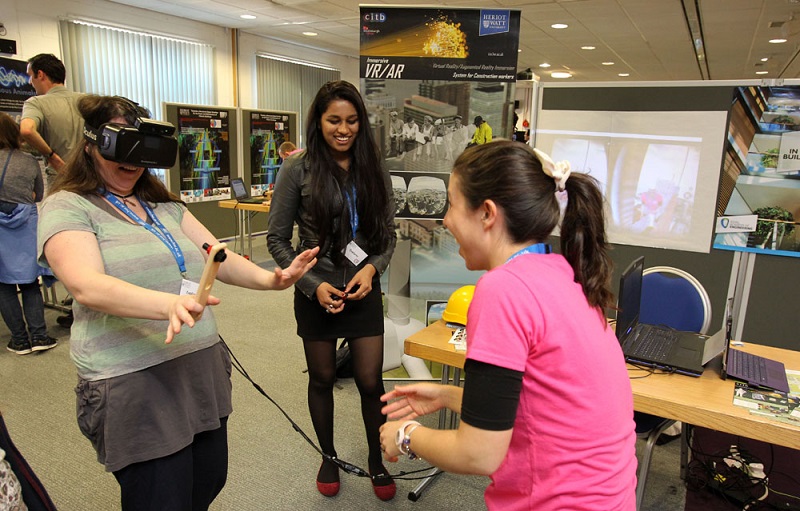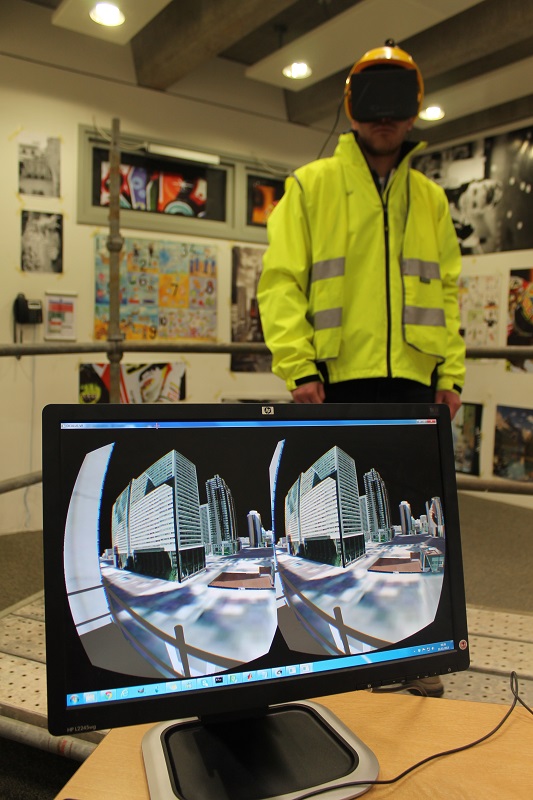Immersive Hybrid Reality iHR
Experts in construction and computer technology at Heriot-Watt University have developed a ground-breaking immersive hybrid reality (iHR) system which aims to take the danger out of extreme working conditions. The system enables users to experience work activities within realistic site conditions, such as working at extreme height, without facing real health and safety risks.
The iHR system, which is funded by the Construction Industry Training Board (CITB), uses state-of-the-art wearable computer systems and a specially-modified virtual reality (VR) headset to enable trainees to see, navigate and interact with real and virtual objects in a realistic working environment.
The iHR recently won a CIOB highly commended Innovation Award in the Innovation in Education and Training category.
The iHR system is hosted at Edinburgh College. The Energy Skills Partnership (ESP) and Fife College are also investing in an iHR pilot system for wind turbine training, in collaboration with the Offshore Renewable Energy Catapult. The pilot project mimics inspections on the top of wind turbines.
Dr Mohamed Abdel-Wahab from Heriot-Watt University said:
“The combination of real and virtual worlds provides trainees with a vivid, yet safe and realistic, experience of a jobsite. The iHR system could support the delivery of training in many areas of the energy, engineering and construction sectors. Indeed the application of iHR can enhance the quality of training provision.”
Dr Frédéric Bosché said:
“The system also delivered additional benefits in terms of engaging young people in STEM subjects in general, and energy, engineering and construction in particular. The team has developed a mobile version of the system (called MobiHR), that we have used to support our partner colleges in numerous Skills and Careers Fairs. Young people are excited about such new technologies, but would never associate them to industries like Construction that are often seen as anchored in old traditions, “not cool”. At those events, we believe our system helps inspire young people.
“From a technical viewpoint, our system delivers what we have called 'hybrid reality'. We use this term to differentiate its functionality from Augmented Reality (AR). In AR, the virtual content is always on top of the real views. In HR, the 3D structure of both worlds are accurately captured and merged so that if the user aims to put their hand beneath a virtual table, it will actually appear beneath the table (i.e. occluded by the table). Furthermore, the user can actually interact with virtual 3D objects. Traditional AR technology cannot deliver this.”
[edit] Related articles on Designing Buildings
- 3D MOVE: Mobile Immersive Visualisation Environment.
- Assisted reality aR.
- Augmented reality in construction.
- Building information modelling.
- Construction drones.
- Digital Built Britain.
- Gravity Sketch.
- Integrated modelling, simulation and visualisation (MSV) for sustainable built healing environments (BHEs).
- Integrated systems.
- The Palimpsest.
- TruVision.
- Virtual reality and manufacturing.
- Virtual reality in construction.
- Visualisation.
- Wearable technology.
Featured articles and news
The UK's Modern Industrial Strategy: A 10 year plan
Previous consultation criticism, current key elements and general support with some persisting reservations.
Building Safety Regulator reforms
New roles, new staff and a new fast track service pave the way for a single construction regulator.
Cooling centres and cool spaces
Managing extreme heat in cities by directing the public to places for heat stress relief and water sources.
Winter gardens: A brief history and warm variations
Extending the season with glass in different forms and terms.
Restoring Great Yarmouth's Winter Gardens
Transforming one of the least sustainable constructions imaginable.
Construction Skills Mission Board launch sector drive
Newly formed government and industry collaboration set strategy for recruiting an additional 100,000 construction workers a year.
New Architects Code comes into effect in September 2025
ARB Architects Code of Conduct and Practice available with ongoing consultation regarding guidance.
Welsh Skills Body (Medr) launches ambitious plan
The new skills body brings together funding and regulation of tertiary education and research for the devolved nation.
Paul Gandy FCIOB announced as next CIOB President
Former Tilbury Douglas CEO takes helm.
UK Infrastructure: A 10 Year Strategy. In brief with reactions
With the National Infrastructure and Service Transformation Authority (NISTA).
Ebenezer Howard: inventor of the garden city. Book review.
The Grenfell Tower fire, eight years on
A time to pause and reflect as Dubai tower block fire reported just before anniversary.
Airtightness Topic Guide BSRIA TG 27/2025
Explaining the basics of airtightness, what it is, why it's important, when it's required and how it's carried out.
Construction contract awards hit lowest point of 2025
Plummeting for second consecutive month, intensifying concerns for housing and infrastructure goals.
Understanding Mental Health in the Built Environment 2025
Examining the state of mental health in construction, shedding light on levels of stress, anxiety and depression.
The benefits of engaging with insulation manufacturers
When considering ground floor constructions.
Lighting Industry endorses Blueprint for Electrification
The Lighting Industry Association fully supports the ECA Blueprint as a timely, urgent call to action.
























